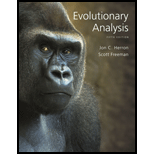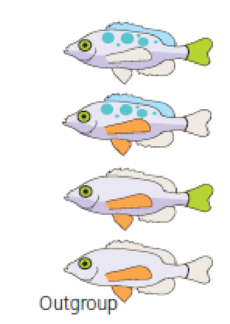
Evolutionary Analysis (5th Edition)
5th Edition
ISBN: 9780321616678
Author: Jon C. Herron, Scott Freeman
Publisher: PEARSON
expand_more
expand_more
format_list_bulleted
Concept explainers
Textbook Question
Chapter 4, Problem 8Q
The four fish in Figure 4.39 evolved from a common ancestor with some homoplasy. What are the possible evolutionary trees for the ingroup? Which is the most parsimonious?

Figure 4.39 Three fish and an outgroup
Expert Solution & Answer
Want to see the full answer?
Check out a sample textbook solution
Students have asked these similar questions
Match the terms to their descriptors. NOTE: If you want to change your selection, you'll need to delete the one you already chose. After you delete it, the list
of choices will pop back up and you can make a different choice.
Two species evolve in different directions from a common starting
point
Divergent evolution
Two species independently evolve similar structures
Homologous structures
Traits that look similar but were not inherited from a common
Convergent evolution
ancestor
Analogous structures
Traits that are similar because they were inherited from a common
ancestor
Below is a cartoon depicting various geological events, starting with one large island (panel 1) and ending with four smaller islands sequentially splitting off from each other
(panels 2 to 5). Initially, there was only Species A inhabiting on the big island. However, as time went on, more species evolved on these smaller islands, such that at the current
time (panel 5), there are five species. Their phylogenetic relationships are shown on the last panel.
1
2
evelves
into
B
specien
3
4
velves
D]
volres
nto
A
5.
2
A
Based on the history depicted, MOST of these speciation events are likely mediated through?
the sympatric speciation process
the reinforcement process
the dispersal and colonization process
the vicariance process
the hybridization process
How, specifically, is the concept of ALLOMETRY relevant to the phylogenetic position of Homo
floresiensis?
Because if allometry explains the anatomy of Homo floresiensis then we can conclude that it is not
separate species but instead a member of our species.
Although most mammals on islands go through a process of getting smaller, Homo floresiensis evolved from
a smaller ancestor to be bigger, meaning that allometry is an important factor.
Mutations in the allometry allele are associated with many of the characteristics of Homo floresiensis.
Because Homo floresiensis is so much smaller than other members of the genus Homo, it is important to
determine how shape changes associated with smaller size impacted the species.
Because Homo floresiensis had both small- and large-bodied forms, variation within the species is in large
part dictated by allometry.
Chapter 4 Solutions
Evolutionary Analysis (5th Edition)
Ch. 4 - According to the evolutionary tree in Figure 4.37,...Ch. 4 - According to the evolutionary tree in Figure 4.37,...Ch. 4 - Sketch a version of the tree in Figure 4.37 in...Ch. 4 - In the tree in Figure 4.37, identify a...Ch. 4 - What is a synapomorphy?Ch. 4 - High-crowned teeth that are well suited for...Ch. 4 - Assuming the four living species in Figure 4.38...Ch. 4 - The four fish in Figure 4.39 evolved from a common...Ch. 4 - What is homoplasy? Why does homoplasy make it more...Ch. 4 - Referring to the information in Figure 4.10,...
Ch. 4 - What is the difference between a molecular...Ch. 4 - Why is it seldom possible to exhaustively check...Ch. 4 - A clade in a phylogeny bears a label at its base...Ch. 4 - Examine the three primate phylogenies shown in...Ch. 4 - Historically, some scientists hypothesized that...Ch. 4 - Sketch the tree you would expect for dogs, wolves,...Ch. 4 - Darwin maintained that among living species, there...
Additional Science Textbook Solutions
Find more solutions based on key concepts
Why are mutants used as test organisms in the Ames test?
Laboratory Experiments in Microbiology (12th Edition) (What's New in Microbiology)
True or false? Some trails are considered vestigial because they existed long ago.
Biological Science
Single penny tossed 20 times and counting heads and tails: Probability (prediction): _______/20 heads ________/...
Laboratory Manual for Holes Human Anatomy & Physiology Fetal Pig Version
Physiology a. deals with the processes or functions of living things. b. is the scientific discipline that inve...
SEELEY'S ANATOMY+PHYSIOLOGY
Some people compare DNA to a blueprint stored in the office of a construction company. Explain how this analogy...
Biology: Concepts and Investigations
Knowledge Booster
Learn more about
Need a deep-dive on the concept behind this application? Look no further. Learn more about this topic, biology and related others by exploring similar questions and additional content below.Similar questions
- The diagram below represents the ranges of 3 species (A, B, and C), which are separated by a mountain range and river. It has been hypothesized that these three species arose via vicariance ecological speciation. Specifically, the entire area was originally occupied by a single species. Its range was split first by the mountain range. Later, the river formed, separating populations on the eastern side of the mountains. If this hypothesis is correct, phylogenetic analysis should reveal that: NIS 4 44444 U LEL B All three species are equally related to each other. Species A and B are each other's closest relatives (sister taxa). Species B and C are each other's closest relatives (sister taxa). Species A and Care each other's closest relatives (sister taxa).arrow_forwardCan you answer all the parts to this diagram Species 1 and 2 are sister species from which you’ve cloned related genes. On the gene tree on the top of the next page, use labels to answer the following questions: (a) Label the node that represents a gene duplication with “D,” (b) Label the nodes that represent speciation events with “S,” (c) Pick a pair of genes that are paralogs and label them both “P.” (d) Pick a pair of genes that are orthologs and label them both “O.”arrow_forwardWhat is the sister taxon of Taxon 3. The sister taxa or clade of Taxon 1? The sister taxon or clade of the Outgroup is?The most recent common ancestor of Taxon 1 and Taxon 3 ? The most recent common ancestor of Taxon 2 and Taxon 3? How many clades (if any) are nested within the Ingroup? If we don’t count the terminal nodes (the tips), how many clades are depicted in the tree?arrow_forward
- Most fish species are considered cold-blooded because they can't generate body heat like birds and mammals. Billfishes and Tunas are notable exceptions. These fish can generate significant amount of body heat and are thus considered warm-blooded. The tree below shows the relationship among several species of fish including billfishes and tunas. The triangles show the inferred origins of "warm-blood" in billfishes and tunas. Knowing that the most recent common ancestor of all the fish in the tree was cold-blooded and that all the fishes in the tree except tunas and billfishes are cold-blooded, what can be said?arrow_forwardWhat are homologous structures? Give an example. Is it necessary that homologous structures always have a common ancestorsarrow_forwardCrickets have colonized each island in the Hawaiian Archipelago. Geological data indicates that Kauai is the oldest island in the chain and Hawaii is the youngest. Researchers hypothesized that crickets sequentially colonized islands as they rose out of the ocean and created a cladogram based on molecular relationships to test this idea. 3) Which islands unambiguously show multiple independent colonization events? 4) How many colonization events were there on each of the islands showing multiple events?arrow_forward
- Can you describe how Kimura's theory of neutral evolution is different from the theory of evolution by natural selection? How are they the same?arrow_forwardThe image below shows how the Pokemon Charmeleon evolves into Charizard over generations. Pokemon fight battles in order to evolve into stronger Pokemon. When Charmeleon (on the left) wins enough battles, they evolve into Charizard shown on the right. If they don't defeat other pokemon they will stay in the form on the left. Explain why this fictional process is not a realistic representation of evolution. Refer to commonly held misconceptions as well as criteria for evolution by natural selection in your answer.arrow_forwardBecause the genomes of chimpanzees and humans are almost identical, and the difference between them are no greater than any two humans, their classification has been changed. Chimpanzees and humans are placed in the same family and subfamily. They are in different “tribes”, which is a rarely used classification category between subfamily and genus. The former classification of chimpanzees and humans placed them in different families. Do you believe that chimpanzees should be classified in the same family and/or subfamily as humans? Or do you prefer the previous classification? Which way seems prejudicial? Give your reasoningsarrow_forward
- Once nuclear DNA sequencing became fast and able to handle sequencing ancient DNA, living humans were found to have some Neanderthal genes. Is this finding clear evidence that some early modern humans did indeed hybridize with Neanderthals? Why?arrow_forwardWere any of your physical traits autapomorphic or synapomorphic when plotted on the gene trees? Which ones and for which species? Phylogeneticists often refer to these physical traits as “evolutionarily significant,” what do you suppose they mean by this? Were any of your physical traits analogous? Which ones? Why do you suppose some traits can occur multiple times on a tree while others don’t? Given your results from two genes and physical traits, what relationships between species are you certain of? Which ones are you uncertain of? Why? If gene trees have more information in terms of base pairs for generating phylogenies, why do you suppose phylogeneticists even bother using and including physical traits in their analyses?arrow_forwardAnole lizards can be found on many islands in the Caribbean that share similar environmental habitats. Anoles on the different islands share similar ecological morphotypes because of their similar habitats. Anoles on each island have evolved from a common ancestor into a variety of different species that occupy different ecological niches as shown below. Which of the following statements explains how the morphotypes found on one island, and shown in the figure, occurred as a result of speciation? A - Convergent evolution occurred, causing new species to evolve based on diverse new habitats. B - Phenotypic diversification occurred as a result of divergent evolution as the anoles adapted to new habitats. C - Natural selection occurred, so individual anoles with certain phenotypes can survive and reproduce only in a specific ecological niche. D - Reproductive isolation occurred as a result of habitat isolation since the anoles are unable to move into different ecological niches to breed.arrow_forward
arrow_back_ios
SEE MORE QUESTIONS
arrow_forward_ios
Recommended textbooks for you
 Concepts of BiologyBiologyISBN:9781938168116Author:Samantha Fowler, Rebecca Roush, James WisePublisher:OpenStax College
Concepts of BiologyBiologyISBN:9781938168116Author:Samantha Fowler, Rebecca Roush, James WisePublisher:OpenStax College

Concepts of Biology
Biology
ISBN:9781938168116
Author:Samantha Fowler, Rebecca Roush, James Wise
Publisher:OpenStax College
How to solve genetics probability problems; Author: Shomu's Biology;https://www.youtube.com/watch?v=R0yjfb1ooUs;License: Standard YouTube License, CC-BY
Beyond Mendelian Genetics: Complex Patterns of Inheritance; Author: Professor Dave Explains;https://www.youtube.com/watch?v=-EmvmBuK-B8;License: Standard YouTube License, CC-BY